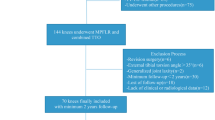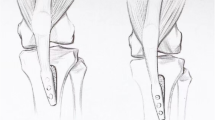Abstract
Purpose
To compare clinical outcome between recurrent patellar dislocation (RPD) with or without actual tibial tubercle lateralisation (TTL) after medial patellofemoral ligament reconstruction (MPFL-R) combined with tibial tubercle transfer.
Methods
From 2015 to 2018, a total of 172 knees with RPD and a tibial tubercle–trochlear groove (TT–TG) distance of > 20 mm were treated with MPFL-R combined with tibial tubercle transfer. Patients were divided into the lateralisation group (TT–PCL > 24 mm, n = 74) and the nonlateralisation group (TT–PCL ≤ 24 mm, n = 60) based on the presence or absence of actual TTL (TT–PCL > 24 mm). Clinical outcomes were assessed postoperatively at a minimum of 2 years. Second-look arthroscopic evaluations were available for 84 knees to assess cartilage damage.
Results
A total of 134 knees with a median follow-up time of 32 months were included. Tibiofemoral rotation (TFR) was significantly higher in the nonlateralisation group than in the lateralisation group (15.4° vs. 9.4°, P < 0.001). At the final follow-up, the nonlateralisation group had significantly lower Kujala (78.2 vs. 86.4, P = 0.001) and Lysholm (80.3 vs. 88.2, P = 0.003) scores than the lateralisation group. At the time of the second-look arthroscopic assessment, 38.9% of the patients in the nonlateralisation group showed cartilage worsening in the medial patellar facet that was significantly higher than that in the lateralisation group (38.9% vs. 12.5%, P = 0.015).
Conclusion
Patients with RPD and an increased TT–TG distance of > 20 mm but without actual tibial tubercle lateralisation benefit less from tibial tubercle transfer than patients with actual tibial tubercle lateralisation, which may be related to the significantly higher tibiofemoral rotation angle of the former.
Level of evidence
III.




Similar content being viewed by others
Availability of data and material
The datasets used or analysed during the current study are available from the corresponding author on reasonable request.
Code availability
Yes.
References
Anley CM, Morris GV, Saithna A, James SL, Snow M (2015) Defining the role of the tibial tubercle–trochlear groove and tibial tubercle–posterior cruciate ligament distances in the work-up of patients with patellofemoral disorders. Am J Sports Med 43:1348–1353
Brittberg M, Winalski CS (2003) Evaluation of cartilage injuries and repair. J Bone Jt Surg Am 85:58–69
Chen J, Wu C, Ye Z, Zhao J, Xie G (2022) Tibial tuberosity-trochlear groove distance and its components in patients with and without episodic patellar dislocation: a study of 781 knees. J Bone Jt Surg Am 104:504–511
D’Amore T, Tanaka MJ, Cosgarea AJ (2017) When and how far to move the tibial tuberosity in patients with patellar instability. Sports Med Arthrosc Rev 25:78–84
Dejour H, Walch G, Nove-Josserand L, Guier C (1994) Factors of patellar instability: an anatomic radiographic study. Knee Surg Sports Traumatol Arthrosc 2:19–26
Diederichs G, Köhlitz T, Kornaropoulos E, Heller MO, Vollnberg B, Scheffler S (2013) Magnetic resonance imaging analysis of rotational alignment in patients with patellar dislocations. Am J Sports Med 41:51–57
Dong C, Zhao C, Li M, Fan C, Feng X, Piao K, Hao K, Wang F (2021) Accuracy of tibial tuberosity-trochlear groove distance and tibial tuberosity-posterior cruciate ligament distance in terms of the severity of trochlear dysplasia. J Orthop Surg 16:383
Ercan N, Akmese R, Ulusoy B (2021) Single-tunnel and double-tunnel medial patellofemoral ligament reconstructions have similar clinical, radiological and functional results. Knee Surg Sports Traumatol Arthrosc 29:1904–1912
Flury A, Hodel S, Hasler J, Hooman E, Fucentese SF, Vlachopoulos L (2022) The winking sign is an indicator for increased femorotibial rotation in patients with recurrent patellar instability. Knee Surg Sports Traumatol Arthrosc 30:3651–3658
Franciozi CE, Ambra LF, Albertoni LJB, Debieux P, de Granata GSM, Kubota MS, Carneiro M, Abdalla RJ, Luzo MVM, Cohen M (2019) Anteromedial tibial tubercle osteotomy improves results of medial patellofemoral ligament reconstruction for recurrent patellar instability in patients with tibial tuberosity-trochlear groove distance of 17 to 20 mm. Arthroscopy 35:566–574
Geraghty L, Zordan R, Walker P, Chao TW, Talbot S (2022) Patellar dislocation is associated with increased tibial but not femoral rotational asymmetry. Knee Surg Sports Traumatol Arthrosc 30:2342–2351
Hevesi M, Dandu N, Credille K, Wang Z, Zavras AG, Cregar WM, Trasolini NA, Yanke AB (2022) Factors that affect the magnitude of tibial tubercle–trochlear groove distance in patients with patellar instability. Am J Sports Med 51:25–31
Hiemstra LA, Kerslake S, Lafave MR, Tucker A (2021) Patella alta is reduced following MPFL reconstruction but has no effect on quality-of-life outcomes in patients with patellofemoral instability. Knee Surg Sports Traumatol Arthrosc 29:546–552
Hinz M, Cotic M, Diermeier T, Imhoff FB, Feuerriegel GC, Woertler K, Themessl A, Imhoff AB, Achtnich A (2023) Derotational distal femoral osteotomy for patients with recurrent patellar instability and increased femoral antetorsion improves knee function and adequately treats both torsional and valgus malalignment. Knee Surg Sports Traumatol Arthrosc 31:3091–3097
Kita K, Horibe S, Toritsuka Y, Nakamura N, Tanaka Y, Yonetani Y, Mae T, Nakata K, Yoshikawa H, Shino K (2012) Effects of medial patellofemoral ligament reconstruction on patellar tracking. Knee Surg Sports Traumatol Arthrosc 20:829–837
Leite CBG, Hinckel BB, Ribeiro GF, Giglio PN, Santos TP, Bonadio MB, Arendt E, Gobbi RG (2023) Medial patellofemoral ligament reconstruction in skeletally immature patients without correction of bony risk factors leads to acceptable outcomes but higher failure rates. J ISAKOS 8:189–196
Lin KM, James EW, Aitchison AH, Schlichte LM, Wang G, Green DW (2021) Increased tibiofemoral rotation on MRI with increasing clinical severity of patellar instability. Knee Surg Sports Traumatol Arthrosc 29:3735–3742
Mani S, Kirkpatrick MS, Saranathan A, Smith LG, Cosgarea AJ, Elias JJ (2011) Tibial tuberosity osteotomy for patellofemoral realignment alters tibiofemoral kinematics. Am J Sports Med 39:1024–1031
Nomura E, Inoue M (2005) Second-look arthroscopy of cartilage changes of the patellofemoral joint, especially the patella, following acute and recurrent patellar dislocation. Osteoarthritis Cartilage 13:1029–1036
Pace JL, Drummond M, Brimacombe M, Cheng C, Chiu D, Luczak SB, Shroff JB, Zeng F, Kanski GM, Kakazu R, Cohen A (2023) Unpacking the tibial tubercle–trochlear groove distance: evaluation of rotational factors, trochlear groove and tibial tubercle position, and role of trochlear dysplasia. Am J Sports Med 51:16–24
Parikh S, Noyes FR (2011) Patellofemoral disorders: role of computed tomography and magnetic resonance imaging in defining abnormal rotational lower limb alignment. Sports Health 3:158–169
Schoettle PB, Zanetti M, Seifert B, Pfirrmann CWA, Fucentese SF, Romero J (2006) The tibial tuberosity-trochlear groove distance; a comparative study between CT and MRI scanning. Knee 13:26–31
Schöttle PB, Schmeling A, Rosenstiel N, Weiler A (2007) Radiographic landmarks for femoral tunnel placement in medial patellofemoral ligament reconstruction. Am J Sports Med 35:801–804
Seitlinger G, Scheurecker G, Högler R, Labey L, Innocenti B, Hofmann S (2012) Tibial tubercle-posterior cruciate ligament distance: a new measurement to define the position of the tibial tubercle in patients with patellar dislocation. Am J Sports Med 40:1119–1125
Takagi S, Sato T, Watanabe S, Tanifuji O, Mochizuki T, Omori G, Endo N (2018) Alignment in the transverse plane, but not sagittal or coronal plane, affects the risk of recurrent patella dislocation. Knee Surg Sports Traumatol Arthrosc 26:2891–2898
Tensho K, Akaoka Y, Shimodaira H, Takanashi S, Ikegami S, Kato H, Saito N (2015) What components comprise the measurement of the tibial tuberosity-trochlear groove distance in a patellar dislocation population? J Bone Jt Surg Am 97:1441–1448
Tensho K, Shimodaira H, Akaoka Y, Koyama S, Hatanaka D, Ikegami S, Kato H, Saito N (2018) Lateralization of the tibial tubercle in recurrent patellar dislocation: verification using multiple methods to evaluate the tibial tubercle. J Bone Jt Surg Am 100:e58
Wu G, Cao Y, Song G, Li Y, Zheng T, Zhang H, Zhang Z (2022) The increased tibiofemoral rotation: a potential contributing factor for patellar maltracking in patients with recurrent patellar dislocation. Orthop Surg 14:1469–1475
Xu C, Cui Z, Yan L, Chen Z, Wang F (2022) Anatomical components associated with increased tibial tuberosity-trochlear groove distance. Orthop J Sports Med 10:23259671221113840
Zhang Z, Song G, Li Y, Zheng T, Ni Q, Feng H, Zhang H (2021) Medial patellofemoral ligament reconstruction with or without derotational distal femoral osteotomy in treating recurrent patellar dislocation with increased femoral anteversion: a retrospective comparative study. Am J Sports Med 49:200–206
Zhang Z, Di MLQ, Song G, Li Y, Cao Y, Zheng T, Feng H, Zhang H (2023) Clinical and second-look arthroscopic results for derotational distal femoral osteotomy with medial patellofemoral ligament reconstruction for recurrent patellar dislocation with increased femoral anteversion: a series of 102 cases with a minimum clinical follow-up of 2 years. Am J Sports Med 51:663–671
Zhang Z, Dimeng L, Cao Y, Zheng T, Song G, Li Y, Zhang H (2022) Predictors of graft failure after primary medial patellofemoral ligament reconstruction. Orthop J Sports Med 10:23259671221138856
Author information
Authors and Affiliations
Contributions
ZZ participated in study design, data collection and drafted the manuscript. MD and TZ carried out the radiological measurements. YC and ZF participated in the data collection and statistical analysis. HZ conceived of the study, and participated in its design and helped to draft the manuscript. All the authors read and approved the final manuscript.
Corresponding author
Ethics declarations
Conflict of interest
The authors declare that they have no conflict of interest.
Funding
This study was funded by Beijing Municipal Commission of Science and Technology (Z211100002921043), Beijing Jishuitan Hospital Nova Program (XKXX202211) and National Natural Science Foundation of China (82202777).
Ethics approval
All the procedures performed in this retrospective study were in accordance with the ethical standards of the Beijing Jishuitan hospital, and this study was performed after obtaining approval from our institutional review board (IRB, No. 20230309).
Consent to participate
All the patients provided informed consent before participating in this study.
Consent for publication
All the patients provided informed consent for publication.
Additional information
Publisher's Note
Springer Nature remains neutral with regard to jurisdictional claims in published maps and institutional affiliations.
Rights and permissions
Springer Nature or its licensor (e.g. a society or other partner) holds exclusive rights to this article under a publishing agreement with the author(s) or other rightsholder(s); author self-archiving of the accepted manuscript version of this article is solely governed by the terms of such publishing agreement and applicable law.
About this article
Cite this article
Zhang, Zj., Feng, Z., Di, M. et al. Increased TT–TG distance caused by excessive tibiofemoral rotation predicts poor clinical outcomes after tibial tubercle osteotomy in recurrent patellar dislocation. Knee Surg Sports Traumatol Arthrosc 31, 5162–5170 (2023). https://doi.org/10.1007/s00167-023-07587-6
Received:
Accepted:
Published:
Issue Date:
DOI: https://doi.org/10.1007/s00167-023-07587-6




